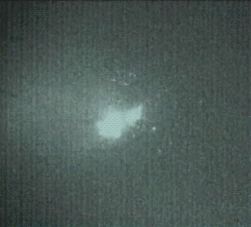Operation Burnt Frost
| Operation Burnt Frost | |
|---|---|

Break up of USA-193 following interception
|
|
| Objective | Destruction of non-functioning satellite USA-193 |
| Date | 4 January – 20 February 2008 |
| Executed by | USS Lake Erie |
| Outcome | Satellite destroyed on 20 February 2008 |
Operation Burnt Frost was the code name given to the military operation to intercept and destroy a non-functioning U.S. National Reconnaissance Office (NRO) satellite named USA-193. The launch occurred on 20 February, 2008 at approximately 10:26 p.m. EST from the USS Lake Erie, which used a Standard Missile-3 (SM-3) to shoot down the satellite. Only a few minutes after launch, the SM-3 intercepted its target and successfully completed its mission, by neutralizing the potential dangers the errant satellite originally imposed. While the threat was mitigated, Operation Burnt Frost has received much scrutiny from other countries, mainly China and Russia.
USA 193, also known as NRO launch 21 (NROL-21 or simply L-21), was an American military reconnaissance satellite launched on December 14, 2006. The USA-193 was owned by the NRO and its precise function and purpose are classified. However, several websites speculate that the satellite was probably a high resolution radar satellite intended to produce images for the NRO. This argument is additionally supported by the fact that the satellite used a similar inclination to that of a Lacrosse Radar Satellite. Lacrosse is a terrestrial radar imaging reconnaissance satellite operated by the NRO. It utilizes a synthetic aperture radar (SAR) to acquire high resolution images regardless of cloud cover.
The satellite was launched from Vandenberg Air Force Base at 1 p.m. PST aboard the Delta II space launch system. This marked the first launch conducted by the United Launch Alliance since it took over the program from Boeing Integrated Defense Systems on December 1, 2006. The successful launch represented a record 49 successful consecutive operational launches for the Defense Department.
While the launch was successful, ground controllers lost control over the USA-193 satellite shortly after it was established on its orbit, and were unable to regain control. The satellite itself posed minimal risk of falling and causing damage. However, the satellite carried hydrazine fuel which is very toxic. In 2008, President George W. Bush decided this risk would be too great and tasked United States Strategic Command to destroy the satellite to preserve human life.
From inception to the successful interception of the satellite, the timeline spanned only a matter of months. However, due to the complexity and coordination involved to the shoot down of USA-193, this timeline could be considered rather compressed.
...
Wikipedia
